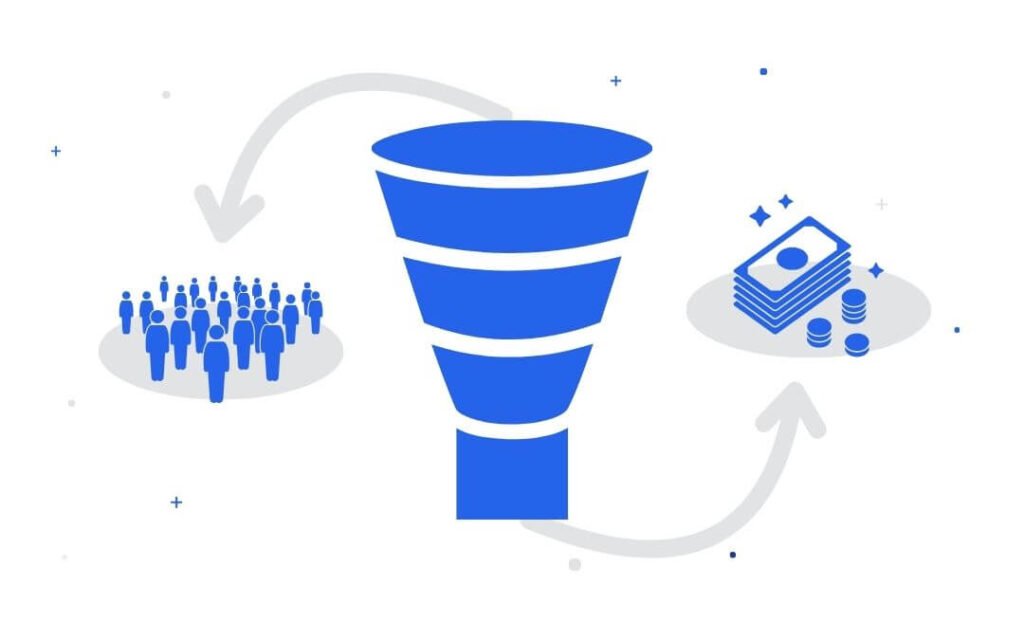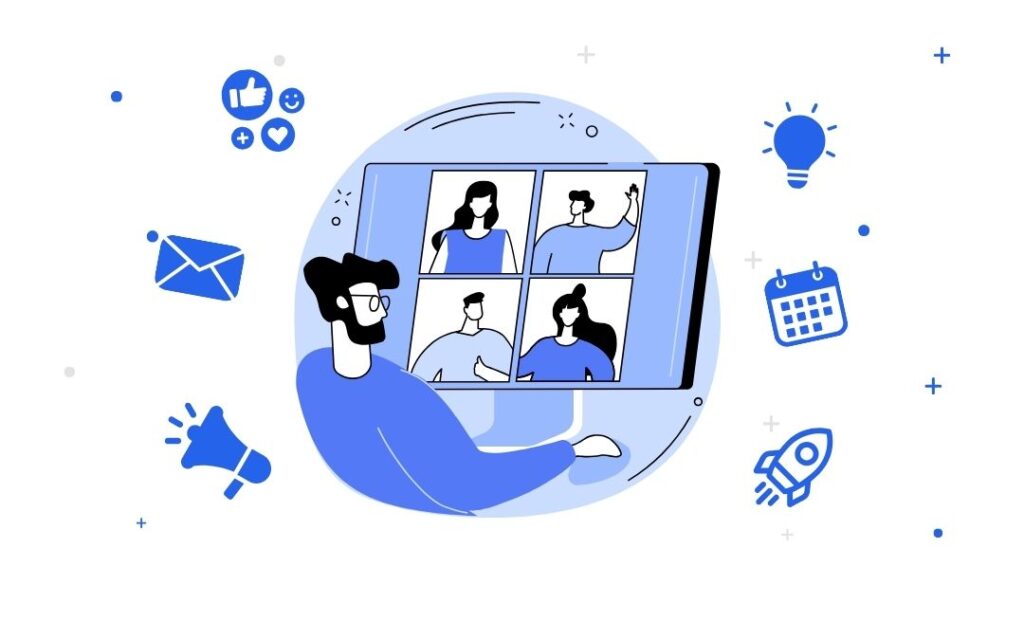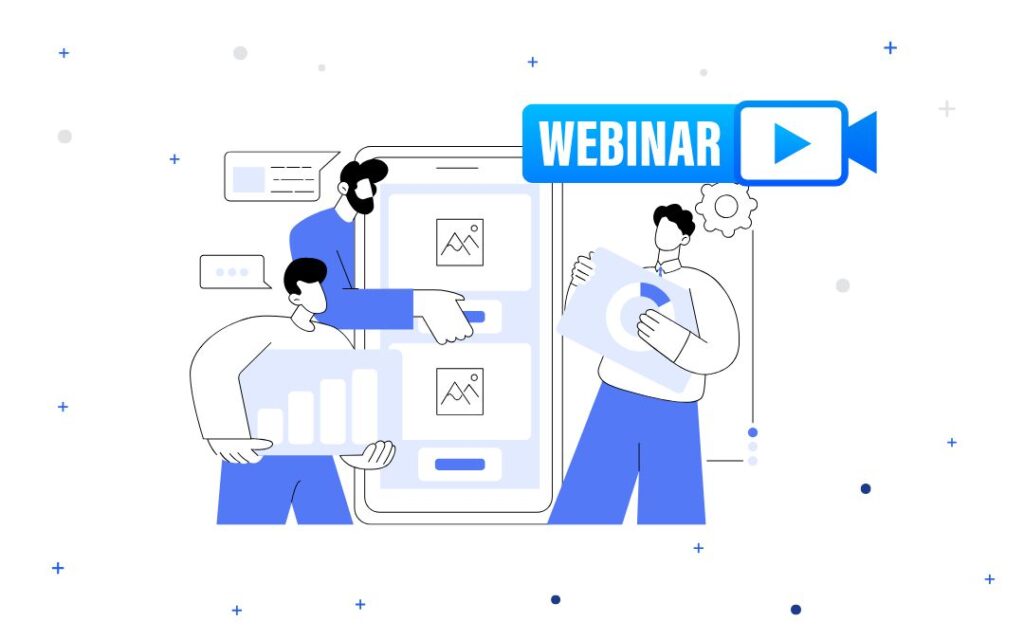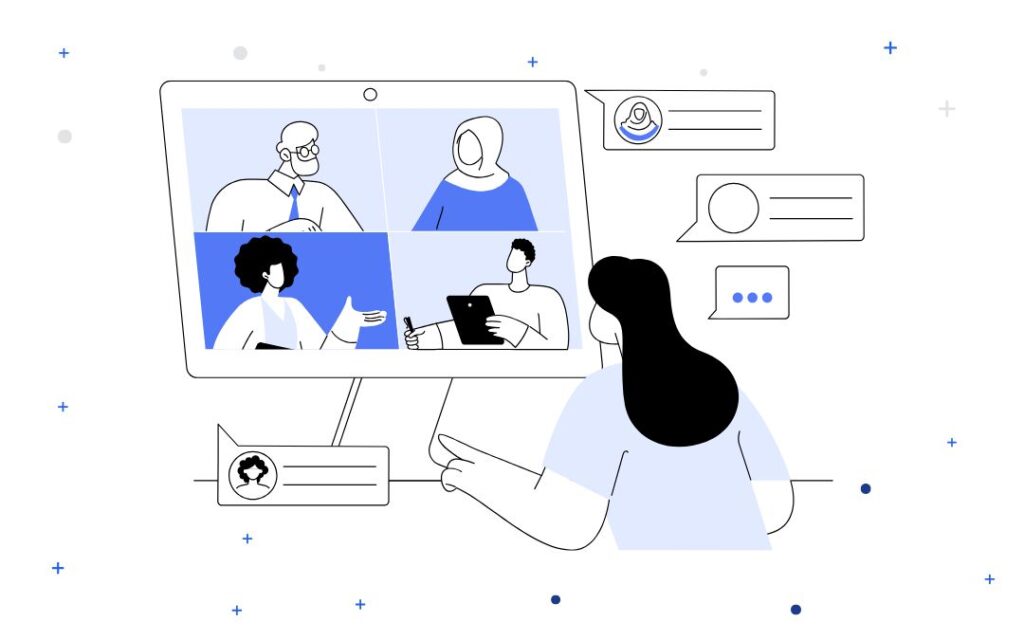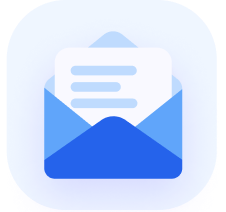A webinar funnel is a powerful tool to engage your audience, generate leads, and drive conversions.
If you can create a successful webinar funnel, you’re on the right track to scaling your online presence and sales.
The fact is that digital marketing is only getting more difficulty as audiences become saturated and competition ramps up. In fact, a recent report indicated that half of digital marketers found it challenging to encourage audiences to move closer to a purchase.
When you integrate the right tools with your webinar funnel, you can automate the entire online event, from registration to post-webinar follow-ups.
Attendees will have a seamless experience from one stage to the next, preparing them to convert.
In this article, you’ll learn how to create a webinar funnel and how it can turn your potential clients into a loyal following.
If you’re looking for an easier way to set up a webinar funnel that converts, sign up for AEvent.
It’s the ultimate webinar automation platform that helps manage events with features like advanced scheduling and real-time engagement analytics.
What is a Webinar Funnel?
A webinar funnel is a strategic model designed to attract and convert potential customers through your online event.
But the funnel is not just about the webinar itself.
It’s an entire marketing system that nurtures leads at every stage of their decision-making journey – from initial brand awareness to purchase and beyond.
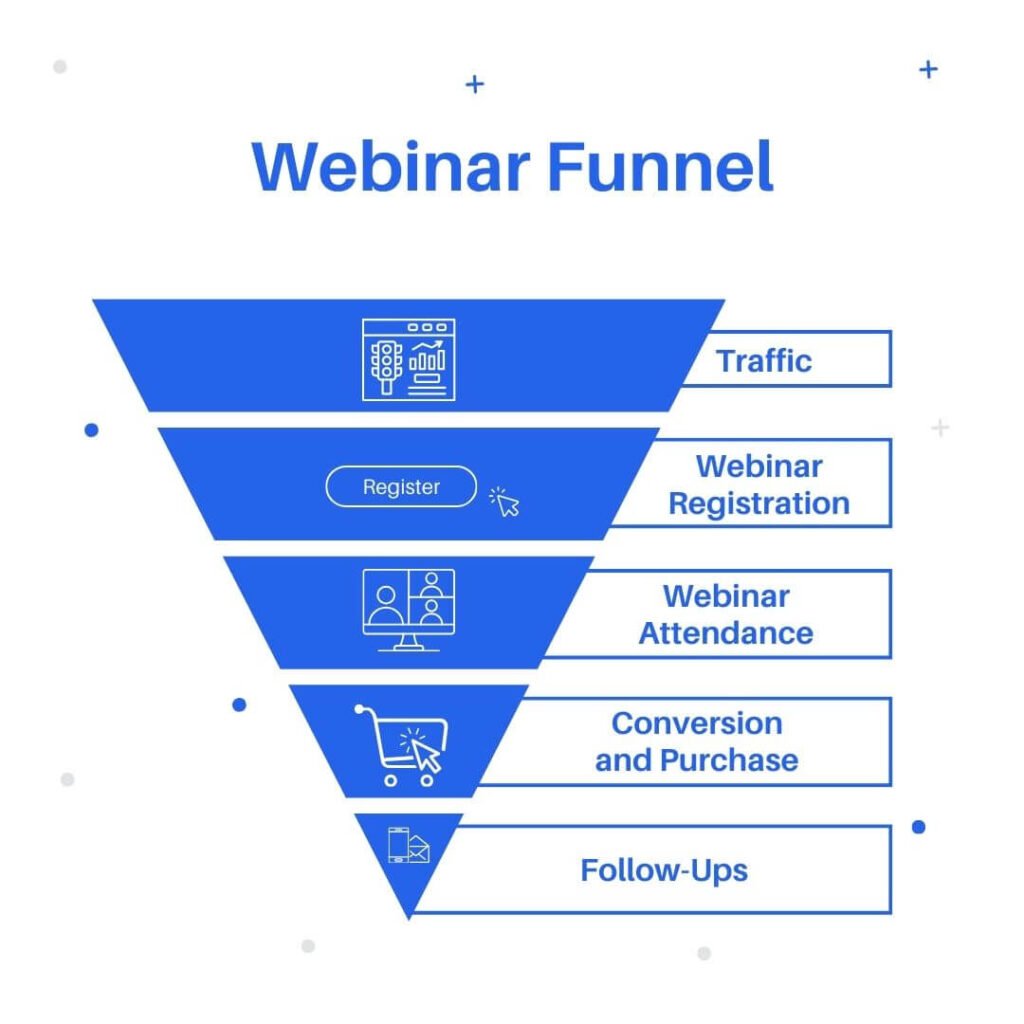
53% of marketers agree that webinars generate higher quality leads compared to other top-of-the-funnel formats.
It starts with creating a webinar presence that encourages people to sign up and attend. Then you provide valuable information based on your audience’s interests, making them more likely to buy your offer.
The Two Funnel Types
Before we go any further, it’s important to distinguish between two very common but very different meanings behind the word “funnel.”
In one instance, funnels refer to the buyer’s journey prospective clients move through from being unaware of your brand to buying and beyond.
The other instance describes a system that captures your lead’s information and stays in touch with them over the course of your relationships. To make things even more complex, this system often uses landing pages called funnels.
In this article, we’re going to be discussing both types of funnels: the buyer’s journey as well as the marketing system for capturing and converting leads.
The 5 Stages of a Webinar Sales Funnel (i.e. the Buyer’s Journey)
The 5 stages of a webinar sales funnel are awareness, interest, consideration, purchase, and post-purchase.
These stages are what your leads go through before becoming loyal customers. So you need to engage them every step of the way.
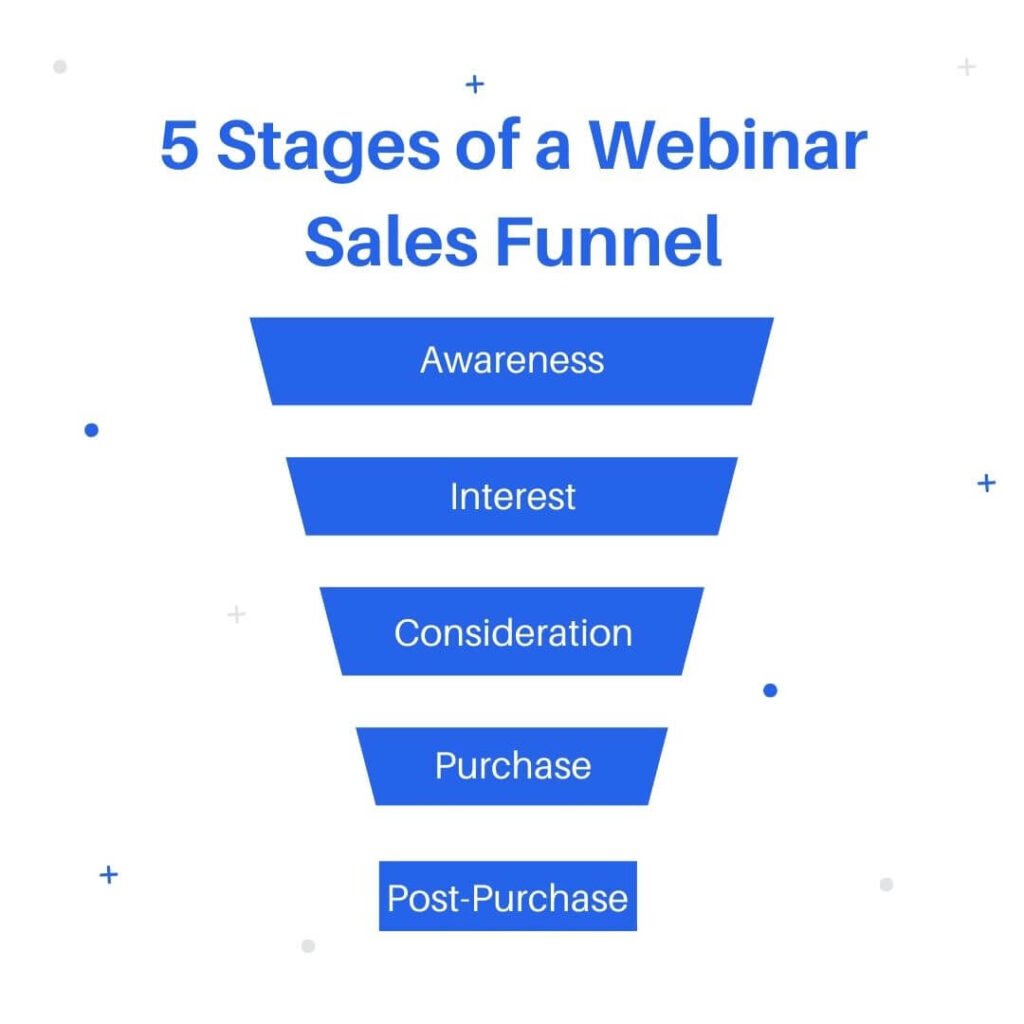
Awareness
The awareness stage is your opportunity to build rapport and credibility with your audience. It’s also known as the top of the funnel.
This is where they might discover your brand while searching for a solution to their problem.
Your goal is to get people to sign up for your webinar. And customers won’t interact with brands they don’t trust or find value in.
So you need to generate interest in your webinar by showing the value of your product or service.
Interest
The interest stage is where you bridge awareness and action. This is where leads move from the top of the funnel to the middle of the funnel.
Potential clients who signed up for your webinar belong to this stage. You need to maintain their interest so they’ll attend your event.
The best way to do this is to create compelling content. Provide sneak peeks, share teasers, and send a webinar opt-in sequence to increase engagement and webinar show-up rates.
Consideration
The consideration stage happens during the webinar itself, where attendees weigh the value of your product or service. Your leads are now at the bottom of your funnel.
You need to strengthen the relationship by showing your expertise, educating them on your offer, and highlighting the unique benefits they’ll receive.
Make it interactive with Q&A sessions and real-life case studies to make your points clearer
This approach positions your solution as the ideal choice and leads your audience to make a decision.
Purchase
The purchase stage is when you nurture attendees into buyers towards the end of the webinar.
Encourage the audience to opt-in to your product or service by adding a strong CTA or offering special promotions.
While this may not create instant conversions, it’s still an opportunity to invite them to future webinars or your webinar replay.
By consistently engaging with webinar attendees, you show your professionalism and foster a relationship based on trust.
Post-Purchase
Your relationship with your customers doesn’t end when they buy. This is where the post-purchase stage comes in.
After they buy, keep them in your email list so they are aware of any new offers you develop and to make sure they know they are a valued client.
They may also be a source of future referrals.
Continuous post-webinar engagement builds a loyal following that can increase conversions for your future events and marketing campaigns.
Webinar Sales Funnels
Webinar sales funnels, like we noted above, are the mechanisms used to get people to register for your webinar and ultimately purchase your offer.
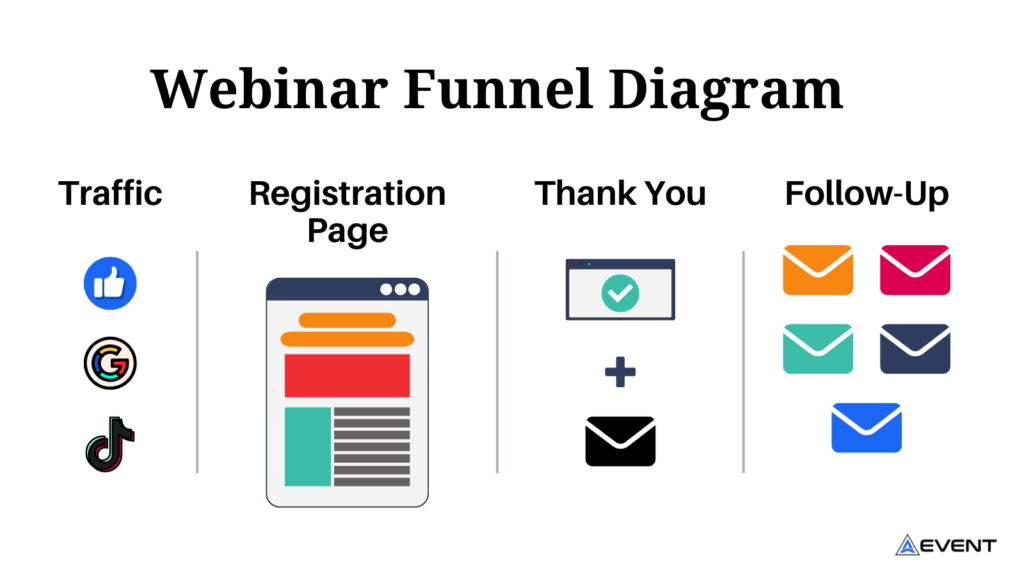
They are comprised of several elements, including:
- Traffic: you’ll need some way to get the word out about your webinar. Whether it’s using your existing email list, running ads to your webinar registration page, using organic social media, or harnessing your website traffic, you can’t get people to sign up for your webinar unless they know abou ti!
- Landing Pages the most common landing page for a webinar is the registration page. This is where people actually sign up for your event.
- Thank You Page: this page appears after someone registers for your event to confirm their spot, thank them for attending, and provide them with event details. An accompanying email confirming all the details is also customary.
- Follow-Up: staying in touch with your audience in between the time they sign up for your webinar the event takes place is critical to increasing your show-up rates. You can use emails, SMS/MMS, ringless voicemail, and social media messages to remind registrants of the webinar.
The diagram above is fairly basic compared to funnel systems we’ve seen but does the job on communicating the mechanism through which people find, register for, and receive communication about your webinar.
How to Create a Webinar Funnel: 10 Steps
There are ten steps you should follow to create a webinar funnel for higher attendance and conversions.
Each step will guide you through the essentials of planning, promoting, and executing a successful webinar that attracts the right audience of potential customers.
1. Identify Your Target Audience
Businesses can enhance webinar effectiveness through audience targeting.
You need to know who your ideal customer is. What are their problems? What solutions are they looking for? What motivates them?
This will help your webinar become highly targeted, with offers that directly address the needs of your audience.
It’s important to understand data like user demographics, interests, or behaviors to create personalized marketing campaigns that resonate.
Visiting sites where your audience spends time can help you identify these trends and deliver relevant content.
2. Set Clear Success Metrics
Setting clear success metrics involves identifying key performance indicators that reflect the outcomes of a webinar, based on its marketing goals. It also helps you identify areas of improvement.
The key is to choose metrics that are specific and directly related to the webinar’s objectives. This includes enhancing brand awareness, generating leads, or increasing sales.
For example, if you’re conducting a webinar aimed at boosting a service’s adoption, your success criteria might look like this:
- Registration goal: 300 sign-ups.
- Attendance goal: 30% attendance rate, equaling 90 participants.
- Interaction goal: 40 interactions, including questions and polls.
- Conversion goal: 15% conversion rate, resulting in 13 new subscriptions.
- Revenue target: With each subscription valued at $1,000, aim for a total revenue of $13,000.
Here are some other success metrics you can use to measure your webinar funnel’s performance:
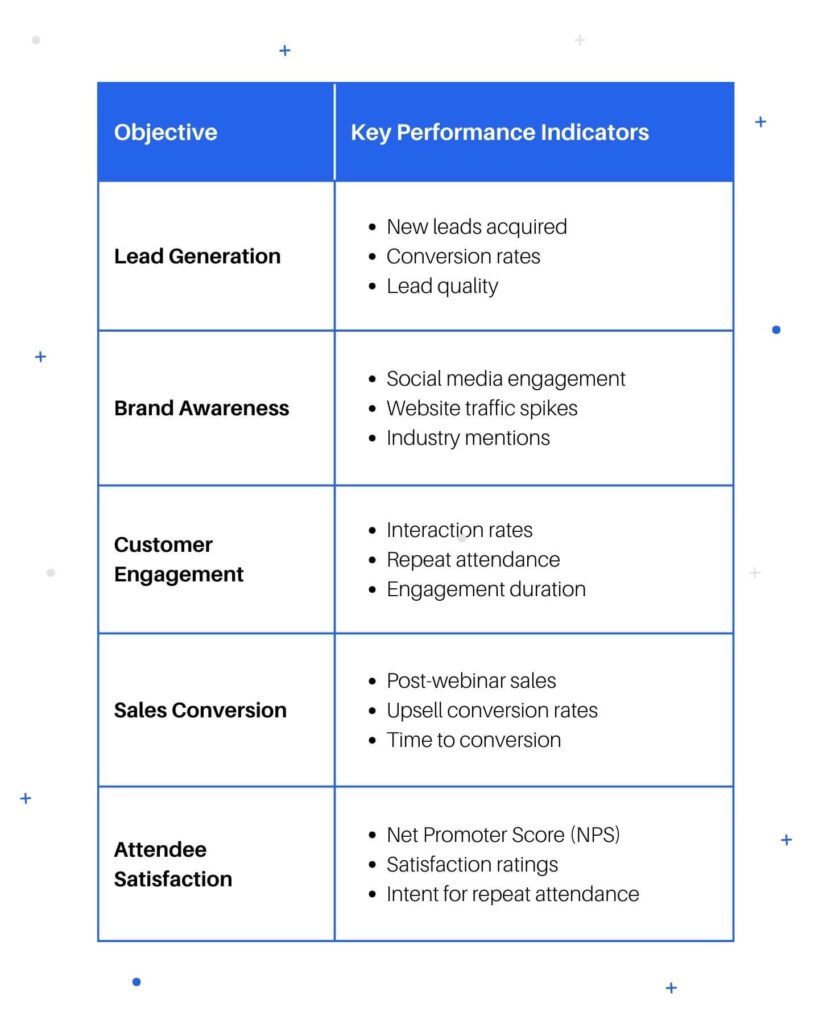
3. Select an Appropriate Webinar Format
Your webinar format should align with your marketing goals for maximum impact, whether it’s selling a product, promoting a new service, or generating leads.
You need to consider the nature of your content and your audience’s expectations to ensure effective communication and interaction.
Here are some examples of webinar formats:
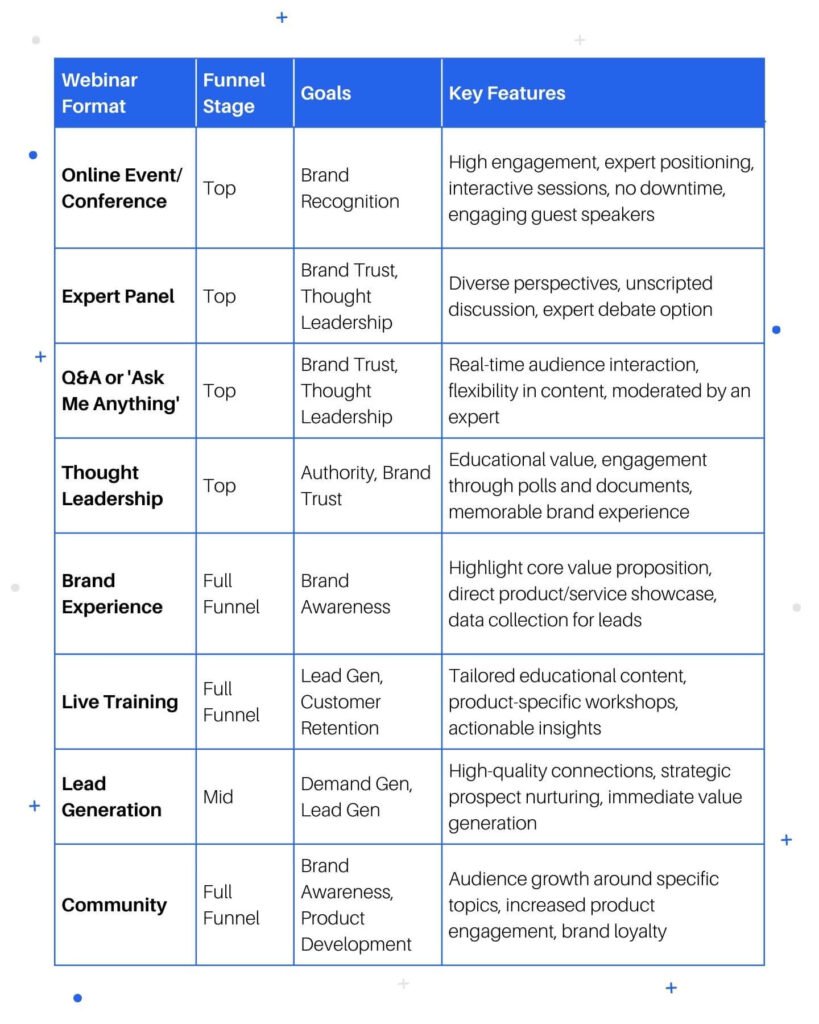
4. Choose the Right Webinar Platform
The right platform ensures you have the proper tools to support the entire webinar lifecycle, including pre-webinar landing pages and follow-up emails. Some popular examples are Zoom webinars and GoToWebinar.
To know which is the right platform for you, consider its compatibility with your existing systems and the number of attendees it can host.
It helps look out for these qualities:
- Simple Setups
A webinar platform with automation features saves time by creating landing pages and sending marketing emails automatically. It helps to have a simple interface with options to set up a webinar timeline for easier event management.
- Attendee Engagement Features
During the webinar, the platform should provide options for audience interaction and engagement. This can be through features like polls, breakout rooms, or Q&As.
- Integration Capabilities
Integrating your platform with a webinar automation software or email marketing tool creates a more efficient and less fragmented webinar experience. For example, AEvent fully integrates with both Zoom and GoToWebinar so you can run your webinars on autopilot.
- Offers Analytics
Access to detailed analytics is essential for understanding the success of the webinar. It offers insights that can help refine future marketing strategies and content.
Repurposing Tools
The best platforms offer tools for repurposing your webinar broadcast. You can automatically create evergreen content that can be shared on-demand.
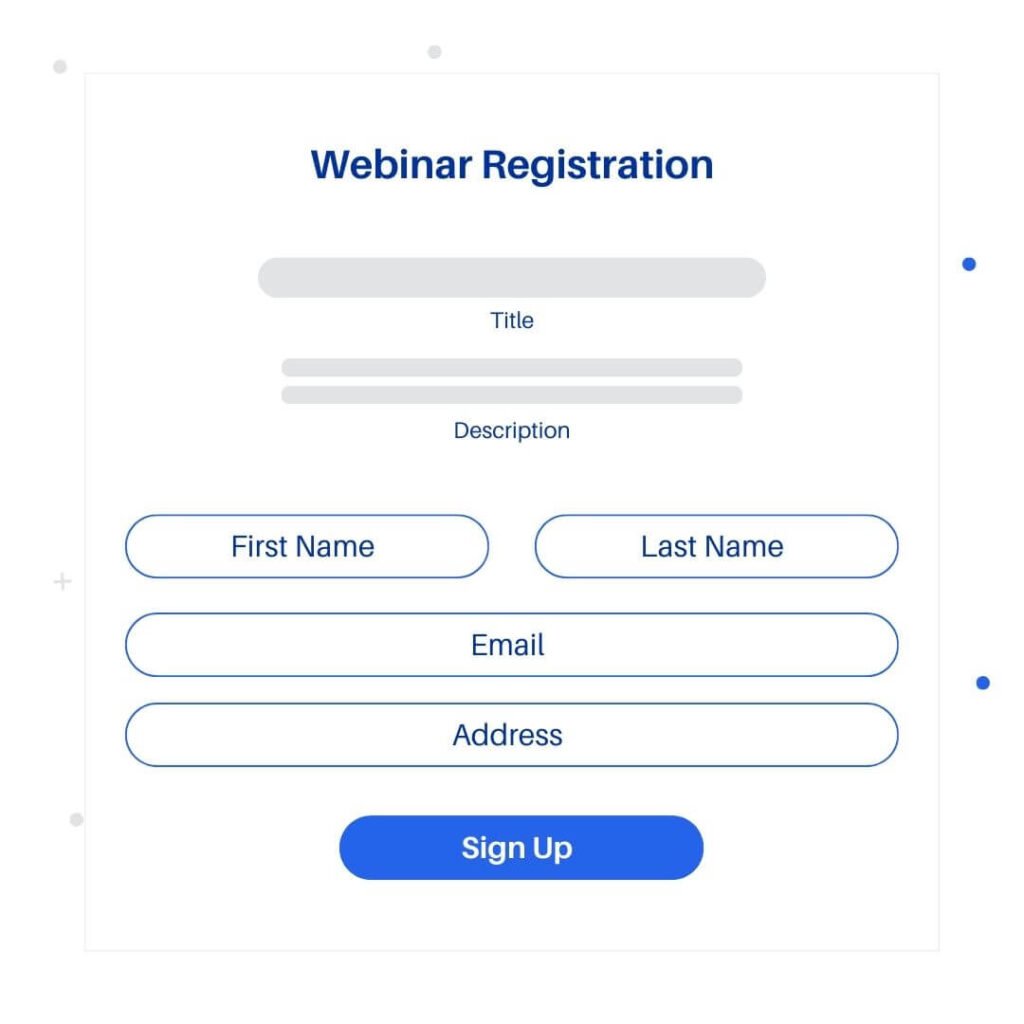
5. Design an Attractive Webinar Landing Page
Your landing page is where leads get their first impression of your brand, which means you need to optimize it for more registrations.
While landing pages are the least popular type of sign-up form, they have the highest conversion rate at 23%.
Here’s what to include on your landing page:
- Catchy headline that states the benefit of the webinar.
- Brief, persuasive description that outlines the topics covered and what attendees can expect.
- Registration form for participants to fill out with their name and contact details.
- Visible call-to-action (CTA) buttons to encourage registrations.
- Presenter bio to establish credibility and connect with the audience.
- Testimonials or social proof to build trust and validate the webinar’s value.
- Details about the webinar including the date, time, and how to join.
Visual elements like images or videos that align with the webinar topic to grab attention.
6. Promote Your Webinar
Promoting your webinar helps you reach a wider audience and drive registrations. Use a mix of channels, including:
Email marketing
Email marketing, in particular, is effective for webinar promotions. 57% of webinar registrations come from email, with a 27% higher conversion rate.
Your emails should be personalized, like mentioning the recipient’s name and including offers based on their previous interaction with your content.
Social media
If you have a substantial social media following, use it to access a larger user base.
Get your existing followers or subscribers to share your content with their networks. You can even create a dedicated event page or group where you can post all your promotional materials.
SEO and organic marketing
Leverage SEO and redirect the traffic from your website to your webinar landing page. Create a banner pop-up and put countdown timers to add a sense of urgency for people to sign up.
Make sure to optimize your content with relevant keywords to improve search visibility and attract organic traffic.
Paid ads
Running paid ads for your webinar on Facebook, Google, and LinkedIn, or leveraging native and display ads helps increase registrations.
You can also use this to retarget people who visited your landing page but didn’t register. To make your ads more relevant, you can set up custom audiences based on user behavior and demographics.
For each promotional tactic, highlight the benefits of attending your webinar. Gather demographic data and address your target audience’s interests and pain points.
7. Host an Unforgettable Webinar
The success of your webinar funnel largely depends on the quality and impact of the webinar itself.
82% of B2B marketers think that attendee engagement and satisfaction are important KPIs for measuring the success of an online event.
Delivering valuable, relevant content is key to keeping your audience interested. This motivates them to take the next step in your funnel.
These are some elements to consider when hosting your webinar:
- Storytelling: Including stories or case studies relating to your audience’s experiences makes your content more memorable and drives your message..
- Interactive Q&A sessions: Real-time Q&A sessions encourage participation and make attendees feel valued instead of just a passive audience.
- Visuals and live demos: Visual aids and demonstrations simplify complex information, making it easier for your audience to understand and remember your key points.
- Exclusive content: Offering content that is exclusive to webinar attendees adds value to the experience. It makes their participation feel special and nudges them to buy your main offer.
- High-quality audio and video: Invest in good-quality technology so your webinar feels professional and free from distractions.
- Consistent follow-up: Sending a follow-up email with a thank you note, additional resources, or a survey for feedback shows attendees their input is valued and encourages future engagement.
- Clear call-to-action: Offer a clear next step for attendees after the webinar, whether signing up for a service, downloading a resource, or joining a community. This helps convert their engagement into action.
If you can make your audience fully engaged and interested through your content, it shows the credibility of your webinar. And it gives you a higher chance of getting them to opt in.
8. Use Webinar CTAs (Calls-to-Action)
Effective webinar CTAs are crucial for guiding attendees toward the next step, like signing up for a trial or making a purchase.
To encourage attendees to take action, incorporate your CTAs strategically throughout the webinar and in your follow-up communications.
Keep in mind that personalized CTAs can convert 202% better than generic ones. You can customize your CTA button, text, and URL to better align with your audience’s preferences.
Experiment with different placements and messaging to find what resonates best, and consider leveraging analytics to track the performance of different CTA versions.
This table shows you the most common types of CTA you can use.
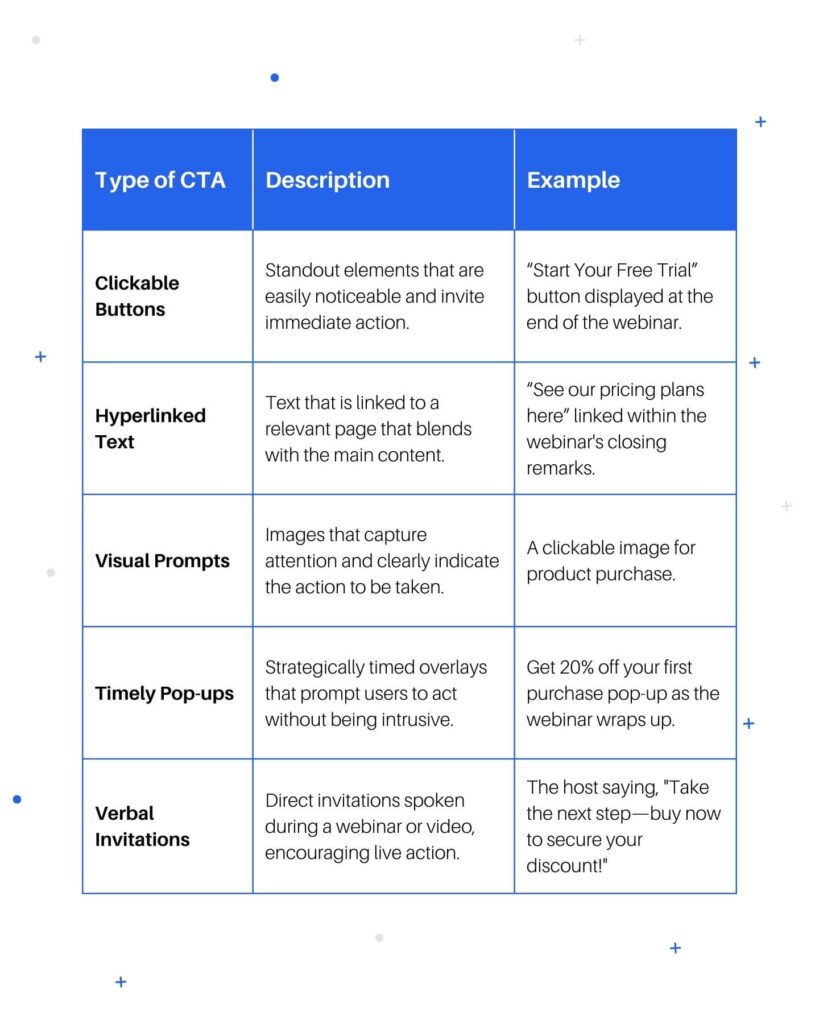
9. Send Follow-up Emails in Webinar Funnels
A single follow-up email can increase the reply rate to 11%.
This shows that you should maximize email marketing for your webinar to maintain engagement with attendees and non-attendees.
These emails can provide access to a recording or resources related to the webinar topic. It can also include special offers or calls to action that encourage further engagement.
With most platforms, you can use their automation feature to send marketing emails based on attendee behavior.
AEvent, for example, lets you send automated post-webinar email sequences for categories like “Attendee,” “Non-Attendee,” and “Cart-Abandoner.”
You can set up these targeted emails to trigger on your specified schedule, say 2 PM on the day after your webinar.
AEvent’s system also allows for detailed segmentation and personalized content, which means each recipient gets an email tailored to their experience and actions.
With its ability to create multi-step email sequences, AEvent helps you nurture leads over a series of days or weeks to keep the conversation going.
10. Analyze and Improve Webinar Funnel Performance
Successful webinars require you to track your numbers. Most platforms have a built-in analytic tool that gives you clear metrics on the reach and effectiveness of your webinar.
Continuous analysis and optimization are key to improving the performance of your webinar funnel. Review the metrics you set at the beginning.
With that, you can assess your webinar’s success and identify improvement areas.
Use the data gathered from each webinar to refine your strategy. Improving your content also enhances the overall experience for your audience.
The better their experience, the higher your conversions.
How Do Webinar Funnels Boost Sales and Conversions?
Webinar funnels are an effective model for scaling your business. They improve your brand presence while increasing sales and conversions.
Brand Identity
Webinars offer an unparalleled opportunity to build and strengthen your brand identity.
By presenting valuable content, you can position your brand as a thought leader and trusted authority in your industry.
According to the Content Marketing Institute, 64% of marketers hosted a webinar in the last 12 months.
This proves that more brands have focused on marketing their brand through online events and on-demand videos.
Webinars allow you to showcase your brand’s values, expertise, and unique selling propositions. It creates a lasting impression on your audience, which leads to increased brand loyalty and conversions.
Audience Engagement
Webinar participants are more inclined to act after actively participating in the learning process.
Engaging directly with your audience builds relationships and drives conversions. You can answer questions, address concerns, and receive feedback from attendees.
Direct engagement fosters a sense of trust and credibility, making attendees more likely to consider your product or service.
By showcasing your expertise and showing the benefits of your offer, you can effectively highlight how they solve specific problems or meet the needs of your audience.
Real-Time Sales
Webinars present a unique opportunity for real-time sales. It enables you to offer products or services to an engaged audience. You can create a sense of urgency by incorporating special offers, discounts, or bonuses that are exclusive to webinar attendees.
This strategy taps into the attendees’ heightened interest and motivation, making them more receptive to making a purchase decision on the spot.
And since you’re talking to an audience in real time, you can address any hesitations and close sales.
For automated webinar funnels, you can simulate this interaction by incorporating pre-recorded segments that respond to common questions.
You can also include limited-time incentives so attendees still feel the immediacy and exclusivity of your offer.
Automate Your Webinar Funnels for Higher Conversions with AEvent
With the right strategy, you can streamline your webinar funnels and increase conversions.
But remember, it takes consistent adjustments and analysis to grow your business. You need to take the right steps to reach your target audience and turn them into customers.
If you plan on maximizing your conversions and upgrading your webinar marketing system, partnering with AEvent is the best solution.
Our platform supports integration with automated funnel software so you don’t have to manage your webinar leads manually.

